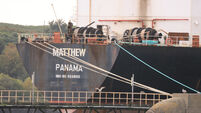Bush waiting to see if Iraq accepts UN resolution
The plan calls for the quick capture of land within Iraq, which would be used as bases to funnel American forces deeper into the country, the New York Times reported yesterday.
Mr Bush, who has publicly acknowledged having received a war plan without mentioning details, approved it prior to the UN Security Council’s vote on Friday last to force Iraq to disarm.














